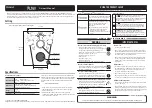
8
Feedback
We love to hear back from you about your experiences, suggestions or comments while working with our instru-
ments.
You can email us at:
info@feeltone.com
Customers from the United States please contact:
gabriele@feeltoneusa.com
Enjoy your New Instrument!
Care and warranty instructions
Wood is a natural material that is alive and reacts with the temperature and humidity. Treat the instrument like you
would treat a violin, harp or other fi ne wood string instruments.
All string instruments appreciate an even room temperature to stay in tune. If the air is too hot and dry, the wood
can dry out and it can form cracks!
We recommend to keep the
humidity between 50%-60%!!!
Care Instruction and Tips to create the best environment for your Instrument:
Don‘t expose the instrument to extreme temperatures, chose a moderate room temperature.
You can use an air humidifi er during the heating period in the winter month or if you live in a dry climate.
Plants in the room with the instrument will help to regulate air moisture.
Important: especially if you have fl oor heating, never set a wood instrument on the fl oor as this will destroy
your instrument by drying out the wood which will result into the wood cracking.
Please note that our warranty is voided, if the instrument was exposed to high temperatures or dry air.


























